Special Feature: Products Sally Recommends
easter markets of germany
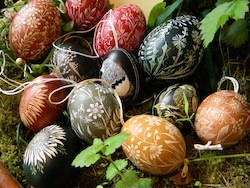 While traveling around Germany for two weeks in April in search of Easter markets, I discovered I was in good – and historical – company. At the New Green Vault in Dresden, I spied a priceless mother-of-pearl chest covered with semiprecious stones and decorated with gold. According to the museum information, the chest was purchased by Elector Christian II at the Leipzig Easter Fair in 1602.
While traveling around Germany for two weeks in April in search of Easter markets, I discovered I was in good – and historical – company. At the New Green Vault in Dresden, I spied a priceless mother-of-pearl chest covered with semiprecious stones and decorated with gold. According to the museum information, the chest was purchased by Elector Christian II at the Leipzig Easter Fair in 1602.
I didn’t buy anything remotely resembling a jewel-encrusted chest, but I did find some treasures for family and friends in a considerably lower price range. (Although almost everything in Euros seems high when prices are converted to dollars.)
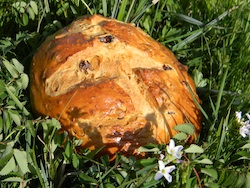 The purpose of the trip was to experience the Easter markets and fairs of Germany, a tradition dating back many centuries. Although not as prevalent or extensive as the German Christmas markets during the Advent season, the Easter markets offer their own special charm and appeal. A bonus is that spring is popping out all over, so the train rides between towns offer spectacular scenery with flowers and trees in full bloom against a backdrop of green lawns and fields.
The purpose of the trip was to experience the Easter markets and fairs of Germany, a tradition dating back many centuries. Although not as prevalent or extensive as the German Christmas markets during the Advent season, the Easter markets offer their own special charm and appeal. A bonus is that spring is popping out all over, so the train rides between towns offer spectacular scenery with flowers and trees in full bloom against a backdrop of green lawns and fields.
The concept is the same as the Christmas markets – little stalls full of seasonal arts, crafts and décor, usually in an outdoor setting. There is a festive feeling as people of all ages wander amid the booths, browsing the items for sale, stopping for a sausage or beer or soft drink. There is no gluhwein (hot spiced wine) because the weather is warm, but there is plenty of excitement in the air.
Because the Easter markets tend to be only on the weekends while many Christmas markets are open every day, you need to plan your itinerary to allow for sightseeing and museum visits during the week, and fair-going on the weekends. In a country like Germany with so much history and so many castles, museums and other sights to see, filling the weekdays is no problem.
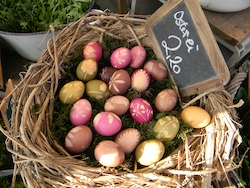 We began our explorations in Wiesbaden, a historic thermal spa town less than an hour by train from Frankfurt. As far back as the Romans, people have come to the area to enjoy the therapeutic hot waters of the 27 springs. Culinary fans will want to sample a local specialty, the pineapple chocolate tartlet made by the Kunder chocolate company -- the original Wiesbadener ananas tortchen.
We began our explorations in Wiesbaden, a historic thermal spa town less than an hour by train from Frankfurt. As far back as the Romans, people have come to the area to enjoy the therapeutic hot waters of the 27 springs. Culinary fans will want to sample a local specialty, the pineapple chocolate tartlet made by the Kunder chocolate company -- the original Wiesbadener ananas tortchen.
The Easter market is situated in the heart of the old town, with matching off-white tents for each stall. Shoppers find lots of decorated eggs, floral and topiary decorations, special liqueurs and local wines, items made with honey and beeswax, lots of textiles, jewelry, glass and porcelain, wood carvings, and more. Live bands perform throughout the weekend, and food booths are everywhere with picnic tables available to enjoy your sausage or pretzel.
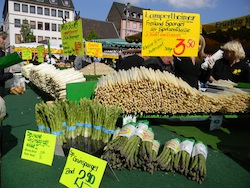 The regular food market also shows signs of the Easter season, with stacks of brightly colored eggs and huge piles of asparagus, both white and green.
The regular food market also shows signs of the Easter season, with stacks of brightly colored eggs and huge piles of asparagus, both white and green.
In Nuremberg, the Easter market is in the Hauptmarkt square in front of the Church of Our Lady, the same place the famous Christmas market is held. Like the Christmas market, the Easter stalls are topped with the city’s signature red-and-white awnings. In addition to the Easter arts, crafts and gift items for sale, there is clothing, housewares, beer steins, lace and much more. When you need fuel to propel you through the market, it’s a must to try a “drei im weckla” – three Nuremberg sausages in a bun.
There’s so much see while in Nuremberg. We spent a full day at the Documentation Center at the Nazi Party Rally Grounds and the recently opened Memorial Nuremberg Trials, a museum that includes the actual courtroom used for the Nuremberg international military tribunals held after World War II. It was a sobering and educational day full of history. Of course, there’s also the walled city itself, the beautiful castle and many other museums and attractions.
A train and bus ride took us to Dinkelsbuehl, a medieval walled city that somehow escaped damage during the war. It has been “rediscovered” by artists and tourists who enjoy its beautiful architecture and charm. This old imperial town has celebrated a spring fair since ancient times.
My favorite Easter market of the trip was located in the courtyard of the ancient almshouse and inside in rooms with vaulted arch ceilings.
The Dinkelsbuehl Easter market offered exquisite hand-painted eggs of all sorts, spring decorations, wooden crafts, and a blacksmith, weaver and basket maker demonstrating their crafts.
The kuchle booth was a busy place, with two women shaping the dough over wooden molds into the classic ring form, another woman frying them to a perfect golden, and another woman sprinkling the hot fried pastries with powdered sugar and selling them as fast as they were made. Another woman had a portable smoker full of local carp and trout, a local delicacy. The ice cream stand, petting zoo and merry-go-round kept the youngsters happy and busy.
The next stop on our itinerary was Dresden, in what was formerly East Germany. This city is one of the most beautiful in Europe, and the reconstruction and restoration is continuing at an amazing pace. The Frauenkirche, the symbol of the city that was destroyed during World War II, is now restored and reigns in the center of the old town. The Zwinger, the royal palace, the opera house and other churches, plus amazing collections in the Historic and New Green Vaults and the Turkish Chamber, will keep visitors busy for days.
Foodies will want to make a stop at Pfunds Molkerei, which claims to be the most beautiful dairy store in the world. The interior of the shop, established in 1880, is completely covered with hand-painted Villeroy and Boch tiles. Today the shop sells an upscale assortment of imported and domestic cheeses. Upstairs there’s a café where you can enjoy a tea or coffee and a local pastry or two.
The Dresden trade fair center is housed in what used to be the city’s slaughterhouse complex, but today is totally retrofitted for trade and commercial fairs. The Easter fair was in this historic building, and offered a mind-boggling array of goods: plants and orchids and flowers of all sorts, housewares, agricultural supplies, animals, jewelry, wooden crafts, and more.
My favorite part was the area filled with artisans, many of them demonstrating their crafts, where a variety of Easter items were for sale, The decorated eggs represented techniques from many parts of Eastern Europe. Many of the sellers were dressed in traditional clothing.
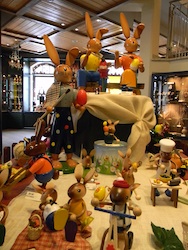 A side trip to the Ore Mountains to the towns of Seiffen and Freiberg was a highlight of the voyage. I’ve long been a fan of the wooden ornaments made in this area and known worldwide as traditional Erzgebirge crafts. The weather in the mountains changed from springtime to a heavy snow and our visit to this area famous for Christmas ornaments looked like a snowy Christmas scene.
A side trip to the Ore Mountains to the towns of Seiffen and Freiberg was a highlight of the voyage. I’ve long been a fan of the wooden ornaments made in this area and known worldwide as traditional Erzgebirge crafts. The weather in the mountains changed from springtime to a heavy snow and our visit to this area famous for Christmas ornaments looked like a snowy Christmas scene.
We visited the original workshop where the steps for producing the nutcrackers, angels, miners and other figures are demonstrated. Each store we stopped in offered a slightly different assortment of hand-crafted items, because each craftsperson has his/her own style. For Easter, there’s an explosion of rabbits, chickens, flowers and other symbols of spring, all crafted in wood in the traditional style. Although there was no Easter market per se, each shop in Seiffen was a market of sorts.
Nearby Freiberg, known as the silver town for its mining history, has the magnificent Cathedral of St. Mary, and the restored Castle Freudenstein houses an amazing collection of minerals, called Terra Mineralia.
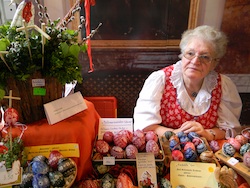 We wound up our trip at the International Easter Egg Market in Mannheim, where artists from several countries displayed amazing creations using eggs of all sorts and sizes. Most were demonstrating their craft, and were eager to explain the process and history of the techniques. Some used paint, others used wax, others etched the designs with small knives. Patience is a key ingredient for each of these traditional art forms.
We wound up our trip at the International Easter Egg Market in Mannheim, where artists from several countries displayed amazing creations using eggs of all sorts and sizes. Most were demonstrating their craft, and were eager to explain the process and history of the techniques. Some used paint, others used wax, others etched the designs with small knives. Patience is a key ingredient for each of these traditional art forms.
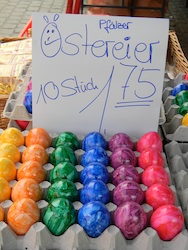 The fair was located in Mannheim’s beautiful Luisenpark, a huge city park that was overflowing with tulips, daffodils, and other spring blossoms during our visit. We also enjoyed touring the magnificent royal palace of Mannheim, wandering its busy shopping thoroughfares, hopping on and off its efficient trams and buses. The fruit and vegetable market on the market square was bursting with fresh asparagus, which is in prime season, and piles of colorful dyed eggs and festive spring floral arrangements.
The fair was located in Mannheim’s beautiful Luisenpark, a huge city park that was overflowing with tulips, daffodils, and other spring blossoms during our visit. We also enjoyed touring the magnificent royal palace of Mannheim, wandering its busy shopping thoroughfares, hopping on and off its efficient trams and buses. The fruit and vegetable market on the market square was bursting with fresh asparagus, which is in prime season, and piles of colorful dyed eggs and festive spring floral arrangements.
Of course, no tour is complete without sampling local fare. In Nuremberg, we had the famous sausages. In Saxony, in both Dresden and Freiberg, we sampled Eierschecke, a treat consisting of a layer of pastry topped with a layer of quark (curd cheese) filling, and another layer of egg-rich custard cake; raisins and almonds are optional.
In Wiesbaden, we tried Eggs in Green Sauce, or Eier in Gruner Sauce, a popular dish in the Frankfurt area year round, but especially at Easter time. The seven traditional green herbs used for the green sauce – borage, chervil, watercress, parsley, salad burnet, sorrel and chives -- are sold in bundles in city markets, wrapped in white paper. It is such a popular dish that Frankfurt celebrates an annual Green Sauce Festival in May. Seven local chefs compete to earn the title of King of the Seven Herbs during the seven-day festival.
Bakeries in every town overflowed with assorted Easter breads and pastries. Asparagus was on menus everywhere, in celebration of the season.
For more information about Easter markets and traditions in Germany, visit www.cometogermany.com and www.germanfoods.org. Frohe Ostern (Happy Easter).
Article and photos copyright 2011 by Barbara Gibbs Ostmann.
![]()
St. Louis-based Barbara Gibbs Ostmann enjoyed the Easter Markets in Germany.
Note: This information was accurate when it was published. Please be sure to confirm all rates and details directly with the businesses in question before making your plans.



